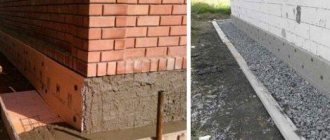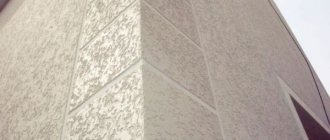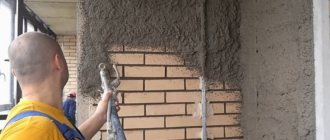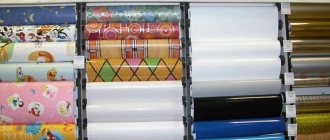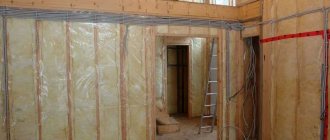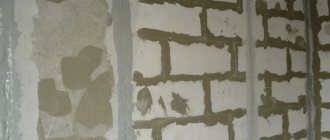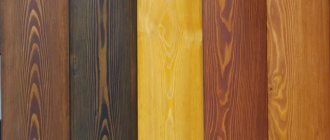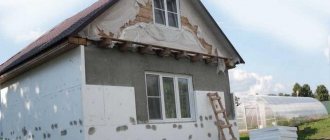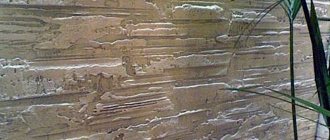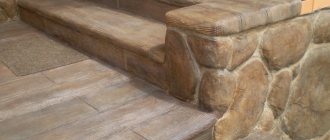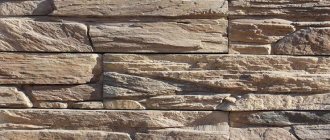Design features of facade systems
Modern decoration of the facade of the house.
Cladding the building is the final stage of construction work.
Designs made from various raw materials are used, for example:
- Sandwich panels are a heat-insulating finishing material with 2-sided protection.
- “Wet stone” or “wet facade” is a technology where insulation is mounted on a treated surface. Additionally, a reinforced layer is installed on which plaster is applied.
- For ventilated structures, an air gap is created between the wall and the decorative elements.
- Aluminum systems are considered the most reliable. They have a long service life. Such structures are coated with special powder paint, which protects the walls of the building from adverse weather conditions.
Fake diamond
Facade finishing with artificial stone.
– this is the name given to two different types of products:
- Various types of synthetic stone products, based on a polyester layer and a filler of natural stone chips.
- Facing products made of colored concrete with a relief surface and a color close to natural stone.
Artificial stone made from colored concrete is used for decorating and cladding the surfaces of buildings and structures, as well as for interior decoration. Both types of artificial stones are imitation of natural materials.
Modern artificial stone is a material that allows you to imitate the cut of natural stone when laying. Artificial stone can be made from white or gray cement, artificial or natural sand, carefully crafted colored stone or high quality natural gravel.
Positive aspects of artificial stone:
- High strength
- Moisture resistance
- Durability
- beauty
Types of facade finishing
There are various options for exterior finishing of buildings. But the compositions and building materials used must perform not only decorative functions, but also protective ones.
Thermal insulation
The finishing upholstery is made from insulation materials. Therefore, in addition to an attractive appearance, they provide the home with increased energy efficiency and prevent heat losses.
Thermal insulation coating of house walls.
Protective and decorative
Fencing systems reliably protect buildings from natural influences. Manufacturers produce single- and multi-layer structures.
Protective and decorative structures for house walls.
"Wet"
To obtain “wet walls”, different building compositions are used: adhesive mixtures, cement mortar, rough and finishing plaster.
Finishing for wet walls.
Mounted
Such systems are manufactured using a mechanical dry method. To fix them, a sheathing is arranged and hardware is prepared.
Hinged ventilated house facades.
Basic requirements for materials
The main criteria for choosing external finishing for a building are: appearance, reliability, price.
High-quality composition
Special attention is paid to the quality of finishing mixtures and solid decorative elements. They must withstand mechanical loads, natural influences, high temperatures, frosts, not fade in the sun, and be resistant to fire.
Harmonious combination of home design with the surrounding environment
The decor should be attractive and combined with the landscape design.
Value for money
It is not recommended to choose the cheapest building materials. There are relatively inexpensive cladding slabs on the market with good performance. You can see the condition of the facades of neighboring houses that were made several years ago.
Protective functions
External decorative upholstery must be resistant to moisture, severe frost, and acid-base compounds.
The upholstery must perform protective functions.
Sandwich panels for facade cladding
The finishing board consists of 3 layers. Insulation (polyurethane or mineral wool) is placed between 2 metal or polymer blanks.
Sandwich panels are characterized by low weight and high thermal insulation properties.
Installation does not require special tools or construction skills. These slabs are affordable for everyone.
Related material: Features of constructing a garage from sandwich panels with your own hands
Sandwich panels for the facade of your home.
The most common methods of exterior finishing
Today there are many options for finishing the exterior of a building. The most common and familiar to many is facade plaster.
Plaster
This method is still relevant today. This method is suitable for facing brick, concrete and block surfaces. The market offers different options for finishing mixtures.
Plaster is a good building insulator and a durable coating that can last up to 50 years without repair. The disadvantage is the dirt when laying walls using this method and the labor-intensive process.
Brick
Facing a building with brick is a reliable protection against negative external influences. At the same time, the house looks beautiful and makes a pleasant impression. It is important that the cladding does not require special care.
The finishing of external walls may be partial. Only the corners of the building can be highlighted with brick, which will give a unique and individual look. Today the market offers many shades of the working product, including facing bricks of various shapes.
On a note! It is important to understand that the weight of the structure due to the use of brick as a finishing material affects the overall weight. Therefore, at the design stage, it is necessary to take this nuance into account.
Stone
Finishing stone (wild or artificial) is the most expensive option. High wear resistance of the working product, external sophistication: this is what can be said about the stone finish.
Siding and wood paneling
An excellent choice for cladding a summer house. Ease of installation and practicality, as well as reasonable cost - these are the main advantages of the wooden structures in question. There are many types of siding. Including:
- acrylic;
- metal;
- block house (imitation logs);
- wooden material and other options.
Installation does not require the use of special tools or fundamental knowledge. What you should pay attention to is the choice of fasteners. Unless, of course, you will be worried about rusty streaks from poor-quality fasteners in the future.
The most commonly used wood is the following:
- Pine.
- Alder.
- Ash.
- Linden.
- Oak.
Experts recommend using moisture-resistant wood. External wood cladding adds warmth and rich decoration to the building. When choosing a tree, you need to know the characteristics of the wood and its features. Including thermal conductivity and moisture/resistance and a number of other characteristics.
Metal cassettes for exterior decoration
This cladding option is used for private houses and public buildings.
Cassettes are mounted in an open (closed) way using self-tapping screws (rivets).
Advantages of metal structures:
- environmental friendliness;
- fire safety;
- resistance to frost, elevated temperatures, aggressive environments, natural phenomena;
- are not susceptible to fungus formation;
- long operational period.
The only drawback is the high price.
Decorating the house with metal cassettes.
Decorating the outside of the house: what material is suitable for the frame type of building
Finishing the outside of a frame house gives rigidity to the structure and removes some of the load from the frame. Before sheathing a house, you need to select a material with sufficient mechanical strength that can withstand compression and work well in bending. It is important that the walls retain their original shape for as long as possible, regardless of environmental conditions. In addition, the cladding must withstand moisture, temperature changes and the influence of various microorganisms. Other important requirements when choosing a material are ease of installation and ease of processing, especially if you plan to do the cladding yourself.
Exterior finishing of a wooden frame house will protect it from rot and fungus
Helpful advice! Whatever panels are chosen for finishing the outside of the house, they need to be easy to cut and drill. The material should not crumble or crack, and the panel must maintain its density at the cut site. Durability is also important so that you don’t have to re-clad the house after 5-10 years.
The following types of materials are most often used for finishing a frame house:
- moisture-resistant plywood;
- cement particle boards (CSB);
- fibreboards (fibreboard);
- oriented strand boards (OSB);
- edged board.
Finishing the outside of a house with OSB boards is the most popular when constructing frame structures. The sheet consists of glued shavings and wood chips, which have a longitudinal arrangement in the outer layers and a transverse arrangement inside. Synthetic resins and wax are used as an adhesive mixture, providing the finished slab with water-repellent properties.
For the exterior finishing of a frame building, fiberboard, edged boards, fiberboard, OSB and plywood are often used
For external finishing, OSB-3 boards are used, which are characterized by increased rigidity, moisture resistance, elasticity and the ability to withstand vibrations. Using OSB boards will help you save money and cover the outside of your house cheaper than when choosing other materials. This is explained by the fact that to give a more attractive appearance, it is enough to treat the surfaces with waterproof varnish or facade paint. Features of using other types of material for cladding the outside of a frame house:
- DSP. It is a compressed mass of cement and softwood shavings. It is durable and has a long service life, and is considered an excellent base for plastering or painting. The plate is designed for 50 freezing and thawing cycles.
- Fiberboard. These are sheets made from compressed shavings; during the manufacturing process they are highly heated, which allows them to achieve maximum density without the use of adhesive mixtures. The natural resin contained in the shavings protects the material from mold. Sheets with a thickness of at least 2.5 cm are suitable for sheathing.
- GVL. Moisture-resistant material consisting of natural gypsum reinforced with cellulose fibers. Its high density makes it suitable for creating surfaces; the sheets are fastened to supporting posts using self-tapping screws. To make the facade attractive, the top is covered with decorative plaster.
The material for cladding a frame house must be of increased strength
Stone for cottages
Natural or artificial rocks are purchased for the exterior cladding of buildings in any climatic zone.
Sandstone
In appearance and size, sandstone resembles limestone. But it is much stronger.
Main characteristics:
- brown, yellow or beige shades;
- rough to the touch;
- light weight.
For façade structures, only pisolite and solitic sandstone are used.
Limestone
For external facing work, durable stone is used, which contains 98% calcite.
Features of limestone:
- easy to process, any shape can be obtained from it;
- the surface is chipped in relief, after grinding it is smooth matte;
- Available in yellow and white colors.
It is not recommended to use limestone for external cladding in regions of the country where the climate is harsh. After sudden changes in temperature, changing seasons, and high humidity, the cladding is destroyed.
Limestone contains 98% calcite.
Slate
Slate is a rough stone resulting from the precipitation of clay or quartz. Its shape is clearly defined, flat, smooth. Slate blanks are lightweight. Advantage: affordable price. Disadvantage: ability to delaminate.
Granite
This is an elite building material. Matte or glossy (polished) granite is used for cladding cottages. Advantage: suitable for all climate zones. Disadvantage: heavy weight, high price.
The plinth is faced with granite.
Quartzite
The raw material has a dense structure, is characterized by increased strength and hardness, but can be polished. Quartzite is fine- and medium-grained. Its processing is carried out with a diamond tool.
Advantages of facing stone:
- refractory;
- wear-resistant;
- frost-resistant;
- resistant to alkalis and acids.
Thanks to these characteristics, the building material is durable.
Gabbro
Gabbro stone has the same structure as granite. This is a crystalline deep rock. More often it is medium- and coarse-grained.
Main characteristics: can be machined, polished, retains its original shine for a long time, is resistant to weathering and frost, high strength.
Marble
One of the most expensive building materials. For facade work, polished stone of medium density is used.
Marble tile cladding.
Plastering as one of the ways to decorate a house beautifully
Plaster has been used as a material for exterior finishing of houses for many decades. During this time, the material has become more improved. Houses whose facades are finished with plaster not only look attractive, but are also durable and sustainable. Using a variety of modern plaster mixtures, you can create relief patterns on the surface of the walls. A thick layer of plaster reliably protects the walls from external influences and various types of damage.
Related article:
Clinker bricks for the facade: reliable and presentable design of the building
History of origin and manufacturing technology of the product. Classification. Installation features. Rating of popular manufacturers and product prices.
Polymer plaster mixture is made on the basis of water-soluble or polyvinyl acetate solutions; it can also consist of polyurethane and epoxy resin. The most common are acrylic plasters, characterized by high adhesion and elasticity. Due to the peculiarities of the composition and the presence of plasticizers in it, the applied plaster does not deform or develop cracks after drying. These positive qualities allow the mixture to be applied to the facade immediately, because the material is not afraid of shrinkage.
This is interesting! Plaster is considered a universal material for home siding because it can be applied to stone, block and concrete surfaces. You can also plaster a facade made of flammable materials. The main advantages are fire resistance and the ability to withstand elevated temperatures for a long time.
Modern plaster for facades is characterized by stability and durability
Another positive quality of this type of exterior home decoration is its versatility, since acrylic is suitable for any type of base: wood, brick, stone or concrete. Disadvantages of using acrylic mixture:
- Poor resistance to ultraviolet rays. With constant exposure to the sun, the coloring substances in the plaster lose their properties and fade.
- Short service life compared to other types of cladding.
- Fast drying. The mixture sets very quickly, which can cause some difficulties for novice craftsmen who want to decorate the outside of a country house with their own hands.
Other types of plaster used for exterior decoration of a house: photos of beautiful facades
Cement-based plaster is used for finishing the exterior of brick houses, concrete and block buildings. The main components are cement, purified and well-washed sand, and lime, which gives the mixture elasticity. The composition also contains plasticizers and elements that add texture.
Plaster based on polymer mixtures is highly elastic
Helpful information! Cement mineral mixtures have good fire-fighting properties and have sufficient vapor permeability. They are sold in the form of dry mixtures, which, after opening the packaging, are mixed with water in the proportion specified in the instructions.
The main advantages of using material for exterior finishing of a house:
- environmental friendliness and natural composition;
- ensuring protection of walls from external influences;
- lack of flammability;
- good heat-shielding and sound-insulating properties;
- compatibility with most building materials used to construct the box;
- long service life - about 50 years;
- low probability of cracks and other disturbances during the shrinkage process of the building.
Before covering the outside of a brick house or a building made of other materials using cement plaster, you need to take into account that the material sets quickly and after mixing the solution it must be used within 1-1.5 hours. In some cases, a finishing material will need to be applied over the cement mixture, which will entail additional costs.
Cement plaster is suitable for finishing concrete, block and brick houses
Silicone plaster is considered the highest quality option for finishing facades, but the material is expensive. In retail establishments, ready-made mixtures are mainly presented, which are sold in plastic buckets. The main positive aspects of applying silicone plaster:
- Good elasticity and adhesion to the surface, which greatly facilitates the application of the solution to the finished base.
- The ability to self-clean, because even during rain, major contaminants are washed off the walls.
- Resistance to sunlight and long-term preservation of the color of the facade without fading.
- There is no possibility of cracks appearing as a result of temperature changes.
It is permissible to apply a silicone solution to any surface, including wood, which the plaster will protect from the growth of fungus or moss. The presence of fine-grained solid additives in the material allows the formation of a beautiful relief on the façade.
Acrylic plaster is considered the most universal, as it is suitable for most types of base materials
How can you cover a house? Another good option is silicate plaster based on liquid glass, which contains mineral additives and coloring pigments. Solutions of various colors are sold ready-to-use. The environmental friendliness of the material ensures the absence of an unpleasant odor and good vapor permeability along with water resistance. Compared to the previous option, it has a more affordable price, while maintaining all the positive qualities. Its feature is neutral electrostaticity, which prevents dust deposition.
External brick cladding: types
This is the most profitable option for exterior decoration. Despite the fact that brick is one of the most expensive facing building materials, this disadvantage is completely covered by a long period of operation.
Ceramic
A single blank costs from 7.6 to 17 rubles. This is the cheapest type of brick. The price depends on the texture of the front side and the manufacturing company. 1 m² of cladding - from 390 to 850 rubles.
Clinker
The most expensive building material, but durable. The cost of 1 product is from 20 to 90 rubles, 1 m² - from 900 to 4300 rubles.
Silicate
This is an environmentally friendly brick. It contains lime and quartz sand. It is frost-resistant and inexpensive.
Hyper-pressed
A building block is 2 times more expensive than ceramic bricks. The price of 1 m² of masonry using the cheapest product is from 900 rubles.
Brick in the cladding of the house.
What is finishing a house with siding: types of material
Siding resembles clapboard. The only difference between them is that one material is attached to the wall surface with an overlap, and the second - using locking joints. Most often, the exterior of a house is finished with siding made of aluminum, although vinyl and wood panels are also considered in demand.
Some options are distinguished by the presence of a polymer coating of various tones, but the greatest demand is for panels that imitate the pattern of wood or stone. You can often find trim on the outside of a house that imitates timber, which can only be distinguished from real wood upon closer inspection. Due to the fact that each panel is laid on the previous one at a large slope, moisture flows freely from the surface without penetrating onto the main wall.
Vinyl, wood and aluminum siding are used to decorate houses.
Helpful advice! Siding is available in single or double panels. To make the house look more attractive, it is recommended to use several different textures for finishing: the base can be finished with stone-like siding, and the rest with wood-like siding. In the photo, houses covered with brick siding cannot be distinguished from ordinary brick trim.
As for the prices of finishing a house with siding on the outside, it is worth noting that using this material you can save a lot of money, because siding is cheaper than natural materials and is much easier to install. At the same time, the panels have a long service life. Another advantage of siding is the ability to use it for cladding buildings made of any material.
Before decorating a house with siding, you should familiarize yourself with the main types of this material. Vinyl sheets are made from high-tech polyvinyl chloride, which can be used at any temperature. The panels are easy to cut, which allows you to create the ideal appearance of the facade, even if there are protrusions and other decorative elements on the base.
Siding is the most economical cladding option, since it is not expensive, and its installation is quite simple.
Vinyl siding consists of lamellas, the thickness of which is 1-1.2 cm, and the width is 20-25 cm. It is mounted on a metal or wooden sheathing. To leave room for possible movement of the lamella, it is not recommended to screw in the self-tapping screw with great force until it stops; it would be better if a small gap remains. To cover the lower part of the building, it is recommended to take not the usual, but the basement type of siding, which is thicker. The main advantages of purchasing vinyl siding include:
- easy installation on buildings of any shape;
- low cost of panels;
- wide temperature range at which installation can be carried out from -5 to +40 °C.
Among the disadvantages is rapid fading under the influence of ultraviolet rays, so preference should be given to light-colored panels. Installation should not be carried out at non-recommended temperatures: if it is too cold, the siding sheets may crack when cutting, and in extreme heat the sheets may bend.
Houses covered with siding: features of metal slats
Metal siding, unlike vinyl, is made from galvanized steel or aluminum. After creating the workpiece, a coloring agent is applied to its surface, which protects the base from rust and corrosion. Decoration of lamellas occurs in two ways:
Metal siding is made from aluminum or galvanized steel and is painted in a variety of colors.
- When using a polymer shell, it is possible to create a large selection of shades and colors. This type of siding does not fade and is not subject to mechanical stress.
- Coloring is carried out using the powder method. The lamellas are designed for operation under any conditions and temperatures. Even when heated, the paint does not peel off or fade, and a large selection of colors and shades is available.
Installation of metal siding is carried out on supporting and additional beams located on the side, using self-tapping screws and connecting locks on the strips. The main advantages are considered to be low cost and the possibility of installation under any conditions, because metal panels, unlike vinyl ones, are not so easy to damage. The disadvantages include the relative simplicity of the facade due to the not very attractive appearance of the stripes.
Thermal panels to beautifully cover the facade
Thermal panel is a universal insulation material that is often used for exterior decoration of building walls. The slab is multi-layered and resembles façade panels.
The internal thermal insulation layer of the structure is made of pressed shavings, polyurethane foam, polystyrene foam, and mineral wool.
The outer layer of the thermal panel is made of PVC panels, artificial stone, marble chips, polymers, clinker tiles.
The bases on which the panels are attached are pre-prepared: leveled, plastered, primed. Special connecting grooves are made on the products. When attaching slabs to walls, adhesives and mounting nails are additionally used.
Brick-like thermal panels.
Wooden cladding of buildings
Wood is often used for both exterior and interior decoration of country houses.
Board
For exterior work, planed or unplaned boards are used. The products are attached to the base horizontally with an overlap (butt-end). According to Scandinavian technology, the boards are laid vertically.
Lining
This is an inexpensive building material, the price of which depends on the width.
For example, lining made from pine costs from 170 to 220 rubles/m², from larch - from 1200 to 1350 rubles/m².
Wooden "Block House"
“Block house” imitates buildings made of logs and differs from lining in its rounded shape.
The cost of a pine product with a width of 13.5 cm and a thickness of 2.7 cm is from 300 rubles/m², size 23x4.5 cm - from 750 rubles/m².
A similar “Block House” made of larch costs 2.5 times more.
Wooden “Block House” - imitation wood.
"Imitation of timber"
The building material looks like lining for facade work, but it is thicker.
A square meter of “Imitation timber” made of pine with a thickness of 1.8 cm costs from 220 rubles, 2.1 cm - from 330 rubles.
The price of “AB” class panels, made of larch, with a cross-section of 2 cm, starts from 800 rubles/m², “Extra” - from 1400 rubles/m².
Beveled slats under the blinds (planken)
The facing material goes well with the architectural style.
“Planken” is a type of cladding board, but without connecting grooves. The blanks are produced with a straight or oblique profile. They differ from “Imitation timber” by the presence of a gap between the individual panels.
"Shingles"
Small-piece building material made of wood. The plates are made up to 40 cm long, 1.5 to 5 cm wide, and 0.5 to 1 cm thick.
All types of wooden cladding are fixed to the sheathing using clamps, mounting nails, and other hardware.
Natural shingles.
Wood paneling
Wood has been used as a construction and finishing material for many centuries. Our time is no exception, and wood finishing remains relevant to this day. In addition to the fact that wood has a natural appearance, it is a material that removes excess moisture, regardless of what material the walls of a residential building are made of.
Wood façade finishing
The most suitable materials for wall cladding are considered to be block house and materials that imitate timber. You can offer lining for exterior finishing, which is thicker than lining for interior work.
Block house is a material that imitates processed logs and is distinguished by a rounded shape of the front part. The material imitating timber is similar to planed square timber. All wood cladding materials are mounted and coated with protective compounds, and they can either be painted or varnished.
Blockhouse finishing
Such facing materials are well suited for decorating walls made of foam blocks. Installation boils down to nailing wood or metal sheathing onto the walls. If necessary, insulation in the form of mineral wool is placed between the guide rails. After this, finishing material is attached to the sheathing.
The cheapest option is to cover the front part of a residential building with ordinary planed boards. The board is mounted according to the same principle as a block house, but it is necessary to ensure that the lower edge of the subsequent board overlaps the upper edge of the previous one by at least 1 centimeter, according to the “bump” principle, which allows you to reliably protect the walls of a residential building from atmospheric precipitation. This is a budget option, although in the end it will turn out quite well if everything is done wisely and slowly.
Planed board finishing
This type of finishing has the same disadvantages as all wood, since it is susceptible to rot and pest invasion. Without appropriate and, as practice shows, annual maintenance, such a surface quickly loses its decorative functions, as it darkens and becomes less and less attractive. Therefore, such material requires constant maintenance, and this is not the principle on which modern developers or owners of private houses rely. As a rule, the owner wants to do everything reliably, quickly and forever, so as not to think about such a problem anymore.
Artificial wood for exterior walls
Many owners of country houses decorate their facades with decorative components that imitate natural wood.
HPL panels
The facing covering is made of cellulose and fiber. These components are pressed under high temperatures.
Advantages of HPL panels:
- low weight of the structure;
- do not require additional processing;
- resistance to mechanical and atmospheric influences;
- easy care;
- durability.
When installed correctly, the structure is quite durable.
HPL panels are durable and lightweight.
Rock
The blanks are produced by pressing stone wool followed by processing with decorative film. Rock panels are often made to look like wood, brick or stone, but they are also available with other decorative options.
The structure is quite light - 1 m² weighs 3 kg. This type of cladding is easy to work with.
The sheets are fixed using special rivets. Rock panels are cheaper than HPL plates. The blanks are resistant to fire.
Tiles on the facade
A broad category that includes small-format and large-format tiles, used both as the main finish and in combination with other materials. Several types of facade tiles are most in demand.
- Concrete - produced in the form of large panels with a brick or natural stone texture, less often in the form of a single “stone”, mounted mainly on a subsystem (clamps, self-tapping screws). A large selection of textures, relatively simple installation, resistance to external influences and durability provide concrete tiles with stable popularity among private owners. Artificial stone for facade finishing, also a type of concrete tile.
- Ceramic (clinker) - when you want a facade made of clinker bricks, but the funds and skill are not enough, use clinker tiles, which have retained all the performance characteristics of the original and differ from it only in their smaller thickness. The method of fixation is adhesive, using specialized mixtures. Today, the finishing layer of clinker tiles is increasingly found on thermal panels and in thermal insulating composite facade systems.
- Porcelain tiles - there is no particular point in placing it in a separate category, since it is also a tile, only large and heavy, which is why it is mounted on a metal subsystem, like facade cassettes. In terms of strength and durability, porcelain stoneware is comparable to brick and stone, but this decoration of the facade of a private house is not particularly common. Porcelain tiles are much more suitable for cladding public buildings and high-rise buildings in modern business class residential complexes.
kisnikFORUMHOUSE Member
Aerated concrete house, insulation, concrete tiles with stone texture on a wooden subsystem. It was possible to do it yourself, quite easily, but there was neither time nor any particular desire to delve into and understand the material. That’s why I chose the turnkey option and I don’t regret it.
Options for finishing country cottages with decorative plaster
This type of finishing is suitable for buildings with complex architecture. Decorative plaster is used for walls made of aerated concrete, shell rock, foam concrete, brick, and concrete. But the bases are pre-leveled with cheaper solutions.
"Lamb"
The “Lamb” plastering technology is simple. The building mixture is applied to the walls of the building in 3 layers. After application, 2 rough coats take 5 hours to dry.
The third decorative layer is applied with a special device that sprays the solution. Convex elements reminiscent of lambs' wool are formed on the processed surface.
"American"
This version of plaster is applied mechanically. “American” is used for cladding concrete, brick, foam concrete walls, fiberboard, chipboard, and cement plaster bases.
This composition is applied quickly, it protects the walls from dirt and damage. It has good noise insulation characteristics and an attractive appearance.
American type plaster.
"Bark beetle"
Facade plaster "Bark beetle" comes in 2 types:
- Mineral (cement-gypsum). Sold in stores in dry form. Such a coating must be covered with a layer of paint made from silicone. If the “Bark Beetle” is not painted, after 2-3 years the decorative plaster will collapse along with the reinforcing layer.
- Acrylic. This plaster is sold ready-made, i.e. the composition can be immediately applied to the surface. Its advantage over mineral is that no additional coloring is required.
The mixture is applied to expanded polystyrene, foam concrete, mineral wool, sandwich panels, aerated concrete, concrete, brickwork, and stone. The coating is resistant to mechanical stress and temperatures -55°С…+60°С.
"Rain"
“Rain” is a special technology for finishing facades, when used, a texture in the form of rain is obtained on the base. For this you can use any structural plaster. The required pattern is provided by fine-grained mixtures.
"Ragged" surface
To obtain “Ragged Stone”, the solution is applied randomly. The imitation of torn sandstone, marble, granite, malachite or rock on the walls is formed using various prints using artistic methods.
"Venetian"
“Venetian” is the most expensive, complex option for external decorative cladding. In this case, special mortars, wax, and paint and varnish mixtures are used.
The technology involves applying up to 5 layers of rough plaster composition. The final decorative surface is formed with a construction spatula using wave-like movements.
Dear Venetian.
"Marble chips"
The basis of “Marble chips” is a mixture of sand and cement. The solution is applied evenly to the surface to be finished. This type of cladding is used for large public buildings.
Additionally, different pigments are used, which are pre-mixed with a polymer composition, then sprayed on the wall with a special device.
Cladding a house with decorative plaster
Where is it used?
Decorative plaster is suitable for houses with complex architecture. It can be applied to walls made of brick, shell, concrete, foam and aerated concrete. But there is a nuance: if the masonry is uneven and the vertical discrepancies reach 2-3 cm, then leveling the wall with layers of plaster is expensive.
The material may crack at low temperatures. Therefore, such plaster is rarely used in the northern regions.
Stores offer several types of plasters, depending on the problems that need to be solved.
Acrylic
Elastic plaster. If you follow the application technology, it will not crack even with slight shrinkage of the house. Resistant to high humidity and frost, vapor permeable. Plaster quickly absorbs dirt, but is easy to clean.
Using acrylic plaster you can create different textures (photo No. 1)
Silicone
It has good wear resistance. With its help you can create different wall textures: grooves, “pebbles”, patterns. Silicone plaster needs to be updated no more than once every 10-15 years.
“Pebble” effect created with silicone plaster (photo No. 2)
Mineral
Consists of cement and colored stone chips. The color range is small - 4-7 colors. Disadvantage: low elasticity. At the slightest shrinkage of the house, the plaster on the outside cracks. This is especially impractical because all new homes are susceptible to shrinkage.
Mineral plaster with marble chips in its composition hides unevenness on the walls well (photo No. 3)
Silicate
It is based on potassium liquid glass, which provides high moisture and fire protection. High vapor permeability and low contamination are the advantages of this material.
Silicate plaster can be applied in a thin layer (photo No. 4)
Pros and cons of finishing with plaster
pros
- Suitable for cladding very complex architectural structures.
- Can be combined with other types of materials.
- Lower price compared to other types of facing materials.
Minuses
- Needs updating and repair every 2-4 years depending on the type of plaster.
- Not suitable for curved walls. It is necessary to first remove the wall so that there is no vertical discrepancy. These are additional costs.
- High requirements for compliance with application technology. Before applying plaster, the walls of the house must be prepared: cleaned, leveled, reinforced with mesh, puttied and primed.
To reinforce the facade, the builders used poor quality glue and mesh, which is why the plaster began to crack a month after application (photo No. 5)
Fiber cement modern panels
For the production of fiber cement panels, sand, cement, cellulose, and additional synthetic-based components are used. The composition is subjected to heat treatment under high pressure. This gives the finished coating increased strength.
Japanese
Japanese slabs, unlike standard fiber cement panels, imitate natural surfaces: wood, brick, stone, even grass. The products are attached to a wooden crate.
Cement particle boards (CPB) “brick-like”
DSP boards differ from fiber cement boards in their manufacturing methods, but they are similar in appearance.
Advantages: fire resistance, good thermal insulation, environmental safety, frost resistance.
Disadvantages: heavy weight of the product, low level of bending strength.
Fastening of cement-bonded particle boards is carried out using rivets or self-tapping screws. The coating requires additional painting.
DSP “brick-like”.
Facade panels
Initially produced specifically for the base, they are characterized by increased strength and resistance to all types of influences, from atmospheric to mechanical. If the siding imitates wood, both in shape and appearance, then the panels repeat fragments of brick or stone cladding; there are also collections for a plaster facade, but less often. The surface can be either smooth, like facing ceramic bricks, or textured, like hand-molded bricks and various types of stone. Panels, like siding, are of several types.
- Polymer - apart from the type, they differ from vinyl siding in greater thickness.
- Fiber cement - the only difference is in shape and texture.
DusyaChashkinaFORUMHOUSE participant
The facade is finished with panels - Japanese, fiber cement, metal subsystem, expensive, but beautiful. All that remains is to finish the blind area. I'm happy with the result!
It is worth considering thermal panels separately, since this relatively new material for facade finishing is both insulation and decorative screen. Unlike polymer and fiber cement panels, thermal panels are fixed directly to the base with glue (adhesive foam) and mechanically, without a subsystem. The thermal insulation layer can be polystyrene foam (EPS), extruded polystyrene foam (EPS, XPS) or polyurethane foam (PPU). The front decorative part is usually made of clinker or ceramic tiles, printed concrete or flexible stone (a combination of acrylic polymer and quartz sand or marble chips).
Vyacheslav715FORUMHOUSE Member
A frame house (OSB exterior cladding) was lined with thermal panels made of polystyrene foam (60 mm) with German clinker tiles in 2003. There are no defects in the facade. It hasn’t been opened, but there are no signs of damage (odor, mold, etc.) in the house, photo – winter 2021.
Facing material siding
Siding is a fairly popular finishing building material. It is characterized by high strength and resistance to natural phenomena. The service life of such decor, depending on operating conditions, is from 25 to 50 years.
Metal
Steel siding is made from galvanized metal or aluminum. The slabs are impact-resistant and can withstand -50°С…+50°С.
PVC
Polyvinyl chloride can withstand frost and is not susceptible to various microorganisms. The cost of PVC panels is less than other materials. The main disadvantage: the fragility of the coating.
Vinyl
Vinyl siding is frost-resistant and can withstand shock loads at temperatures of -60°C. Therefore, such coatings are often used for facade finishing in the northern regions.
Vinyl siding.
Option 3: cladding with piece materials
Exterior decoration of the house can be done with piece materials. Among the advantages of this solution are the following points:
- reliable protection of walls from atmospheric influences;
- the facade acquires a presentable appearance;
- durability.
Of course, along with the advantages, there are also some disadvantages:
- walls under such cladding cannot be insulated from the outside;
- the cost of piece facing materials is much higher than the coatings described above.
Therefore, combined exterior facade decoration is very popular. In this case, piece materials are used only for finishing the base or corners, and the main part of the walls is plastered or finished in other ways, as in the photo below.
An example of combined home decoration
The most popular types of piece materials are:
- stones;
- clinker tiles;
- ceramic tile.
Below we will take a closer look at the features of all these coatings.
Limestone façade
Facing stones
Natural stone is a common finishing material that always looks stylish and fashionable . In addition, this finish is durable and very durable.
True, it should be borne in mind that two stones differ from stone to stone. Therefore, next we will consider the most common types of stones that are used for finishing facades:
| Stone type | Peculiarities |
| Limestone and sandstone | They are beautiful stones that come in a variety of shades. Of course, in addition to visual appeal, their other advantages can be highlighted:
Disadvantages include low strength and porosity. |
| Shell rock | This is also an inexpensive, but at the same time beautiful stone. It has the same disadvantages as the above-described limestone and sandstone. |
| Slate | It is a beautiful and at the same time durable material, which is why it is very popular. It is often used when decorating facades in Provence style. The cost of slate also starts from 400-500 rubles. for 1 m2; |
| Marble | This stone is one of the most famous and widespread. It has a beautiful texture and a rich selection of shades. In addition, this stone can be called eternal due to its high strength and hardness. The only serious drawback of marble is its high cost - the price starts from 3500-4000 rubles. for 1m2. |
| Granite | It has almost the same performance qualities as marble. True, its cost is somewhat lower - from 2,500 rubles per square meter. |
To prevent the porous stone from getting wet and becoming clogged with dirt, it should be coated with a special varnish.
The stone is installed using regular tile adhesive. Since when laying this material you do not need to make even seams and strictly maintain the level, even a beginner can cope with this task.
Clinker tiles
Clinker tiles
Clinker tiles are a beautiful and durable material for exterior wall decoration, which is made on the basis of slate clays. Thanks to a special manufacturing technology, it has the following qualities:
- high strength;
- weather resistance;
- durability - many manufacturers of clinker tiles provide a guarantee of 100 years;
- light weight compared to natural stone.
Facade finished with clinker tiles
Externally, the tiles resemble bricks, so a wall finished with this material is almost impossible to distinguish from brickwork. True, the installation process itself is quite complicated, since the tiles must be located in the same plane and have the same seams.
In addition, the grouting process is quite complex. Therefore, if you decide to tile your house, you will have to turn to specialists for help.
As for the cost of clinker tiles, the price of products from domestic manufacturers starts from 600 rubles per square meter. European tiles cost several times more.
Facade finished with ceramic tiles
Ceramic tile
A good alternative to clinker tiles is ceramic and porcelain tiles. It can be smooth and structured. The latter resembles natural stone, which is why it is very popular.
Sometimes even photo printing is applied to the glazed surface. As a result, the material can have any texture or patterns. Accordingly, this coating looks very impressive.
It should be noted that not only tiles are made from ceramics, but also large facade panels, the width of which can reach 60 cm and the length -180 cm. The panels are easier to install, however, the design of the facade in this case is quite unique. Therefore, tiles are still more popular.
The cost of ceramic facade tiles starts from 400 rubles. for 1m2.
Cladding a house with bricks
Terracotta panels for the exterior of the house
This is a special ceramic coating for facades, in the production of which no synthetic dyes are used. The product is made using special technology from clay.
Terracotta slabs are fired for 10 hours at temperatures above +1000°C.
This procedure provides the product with high strength.
Advantages:
- presentable appearance;
- environmentally friendly material;
- long-term operation.
To increase strength, the panels are impregnated with special agents. The surface is easy to clean from dirt. Products can be selected to match any range of colors.
Terracotta panels made from environmentally friendly material.
Combined facade
To create a more stylish façade finish, you can combine different materials.
Wood and brick
Brick is often used to build the first floor of a country house. It is more resistant to temperature changes and fire. The second floor is built from wood. This allows you to save on the compounds used to construct the foundation.
This combination of building materials provides the building with fire safety and a comfortable microclimate.
Stone effect tiles and wood panels
Wood goes well with stone, and their combination merges with nature. At the same time, small buildings decorated with such materials visually look larger.
Planken plus polished limestone
Limestone lends itself well to processing. Therefore, it is also combined with other facing coatings. For example, “planken” is used as the main cladding of a cottage, and the frame is made of white polished limestone or vice versa.
The house is faced with planken.
No. 6. Concrete facade tiles
The material is produced on the basis of cement, quartz sand, filler and additives.
Advantages :
- durability and moisture resistance;
- strength and rigidity;
- big choice;
- relatively low price.
Flaws:
- poor resistance to temperature changes ;
- large tiles are too heavy for “wet” installation ;
- There are many low-quality on the market with inaccurate geometry.
Tiles for a private house
Facade tiles are used for exterior decoration of both country houses and office buildings. Moreover, this material is suitable for standard, ventilated facades.
Concrete
Concrete panels for exterior finishing of houses are made to look like artificial or natural stone or brick.
Advantages of the coating: ease of installation, large selection of textures, high resistance to precipitation and wind loads, long-term operation.
Ceramic (clinker)
The surface of clinker slabs resembles a brick in texture, differing only in thickness, but at the same time retains all its operational properties.
The building material is fixed to the base using special mixtures or mounting adhesive.
Clinker tiles resembling bricks.
Conclusion
The market has a huge selection of facade materials for every taste and budget, if the budget is limited - siding, panels, plaster or tiles. If the financial side of the issue is not critical and there is an opportunity to spend money on materials and performers - a facade made of brick or natural stone. Regardless of the variety, the materials must be of high quality, and the technology must be followed without a “collective farm”. In cases of outright disregard for the instructions and recommendations of manufacturers, problems will arise with any façade.
On the topic, you can read about the most beautiful and unusual facades of the portal’s participants, as well as about the brick cladding of a house made of aerated concrete and timber. The video contains expert advice on how to choose a facade.
Subscribe to our Telegram channelExclusive posts every week
Beautiful porcelain tile options for a country house
In terms of technical characteristics, porcelain stoneware is not inferior to natural stone. It provides buildings with good heat and sound insulation.
"Arkhskin"
This brand of porcelain stoneware brings together several manufacturers presenting their products on the Russian market. The material is characterized by small dimensions and wide format. The thickness of the slab measuring 3x1 m is from 3 mm, weight is from 7 kg. The advantage of thin porcelain tiles: good flexibility.
"Kerlit"
“Cerlite” is another type of flexible, thin granite. The fairly lightweight material is produced in Italy. The slabs are made in different thicknesses - from 3 to 7 mm.
The production technology involves pressing porcelain stoneware using a fiberglass reinforcing mesh. The firing temperature of the products is +1220°C. The finished building material has high strength, not inferior to natural stone.
In some technical properties, Kerlit even surpasses porcelain stoneware.
"Laminam"
Laminam slabs are made from clay, granite rocks, and ceramic pigments.
Advantages:
- high strength;
- fire safety;
- environmental friendliness;
- frost resistance;
- durability.
The product does not release harmful components into the environment at high and low temperatures, when interacting with water, acids, and alkalis.
Laminam is used to cover the facades of buildings in regions with any climatic conditions.
Laminam slabs for building facades.
Requirements for elements for construction
The main parameters and characteristics of materials for walls are regulated by SNiPs, SP and GOSTs.
For example, SP 31-105-2002 establishes that when constructing walls with a wooden frame, load-bearing structures and frame elements must be made of coniferous trees, which are well dried and treated with antiseptic impregnations in accordance with the standards set out in SNiP 2.03.11.
Such wooden elements must be protected from high humidity during storage and transportation to the construction site. The formaldehyde content should not exceed 5 mg per 100 g of wood. If this indicator is higher, then the tree is treated with a special detoxifying primer.
In the same way, for each other material there are SNiPs, which prescribe the main parameters.
But to summarize,
all materials used must satisfy the following rules :
- Domestic materials must comply with SNiPs, SP, TU and GOSTs, and materials from a foreign manufacturer must comply with technical certificates.
- All materials must have certificates of conformity, fire safety certificates, hygienic certificates, and instructions for use.
- The fire resistance limit of the material must be no lower than REI 150 for load-bearing walls and REI 45 for partitions and non-load-bearing walls (SNiP 21.01-97).
- The material must be such that the finished structure can resist the influence of precipitation as much as possible.
- The walls are laid out from such materials that the wall meets the requirements for strength, thermal insulation, sound insulation, service life, and fire safety.
- The frost resistance of the material used for the construction of external walls must be no lower than F50.
This indicator applies to regions with a temperate climate. For northern regions, the parameter should be at least 30-50% higher.
Stained glass designs
This is an expensive method of finishing facades. Therefore, stained glass systems often decorate commercial and administrative buildings.
Advantages of glass systems for finishing cottages:
- Representative appearance.
- Triplex glass is characterized by good strength. Such surfaces can withstand high mechanical loads.
- Glass is an excellent heat and sound insulator.
- Products can be repaired. If one of the segments of the stained glass system breaks down, there is no need to replace the entire structure. Only the damaged element is replaced.
Disadvantages: difficult to install, high price. But despite the fact that after finishing the finishing work the house takes on a rather expensive look, such facades are not suitable for everyone. Some people feel uncomfortable in all-glass rooms.
Stained glass for finishing cottages.
Cladding a house with porcelain stoneware
Porcelain stoneware is not inferior in its technical properties to natural stone. In addition to the decorative function, porcelain stoneware also has a protective function: it provides sound and heat insulation.
Where is it used?
Porcelain stoneware is used for cladding the facades of office and residential buildings. In Russia they are used mainly for cladding basements or office buildings. The material makes the structure heavier. Therefore, if you plan to use it for cladding a private house, study the house design and make sure that the foundation has a safety margin.
In Russia, façade finishing with porcelain stoneware is rarely used in private housing construction (photo No. 7)
pros
- Increased strength and weather resistance.
- Does not allow moisture to pass through, does not fade and does not lose its appearance. The material reliably protects the facade from destruction.
- Does not require repair. During operation there is no need to update the facade.
- Resistant to mold and condensation.
- Representative appearance.
Minuses
- Heavy weight. Porcelain tiles significantly make the building heavier. It is advisable to take this into account at the design stage.
- High price. The cost of porcelain stoneware and facade cladding work is 2-8 times higher than that of other facing materials.
- Increased requirements for installation quality. It is difficult to find a team that has enough experience working with this material.
Features of self-installation
When performing external finishing work yourself, you first need to create a project, preferably a 3D model. Afterwards, it is recommended to prepare the wall surfaces (level, putty, etc.), the necessary working tools, calculate and purchase a decorative coating.
Tools for work
For installation work you will need:
- primer;
- putty;
- aluminum profiles;
- facing slabs (other material);
- mineral wool, polystyrene foam, other insulation;
- mushroom dowels, other fasteners.
After preparing the tools, working compositions, and finishing materials, it is necessary to clean, level, and treat the surfaces to be finished with protective agents. Only after this can you begin cladding the façade of the building.
Calculations
Preliminary calculations of consumables are the most important stage of finishing work.
The dimensions of the facing slabs are known. And to calculate their number, you just need to measure the area of the house walls, gables, and other areas of the building that require cladding. But it is better to purchase building materials with a small margin, taking into account the need to trim the workpieces.
Thermal panels
Thermal panels perform two functions: they are used for cladding the facades of buildings, as well as for their simultaneous insulation. Therefore, in the factory, a decorative layer is applied to the thermal insulation layer. Thermal panels can be similar in appearance to marble or natural stone, but they do not burn and also do not absorb moisture.
Material options
The main material for their manufacture can be different, but polystyrene foam, mineral wool or extruded polystyrene foam are mainly used. The installation method depends on the material on which the thermal panels are made. If it is polystyrene foam or polystyrene foam, then the plates are simply glued to the surface using a special adhesive. The joints are closed either with special aluminum strips or rubbed with a special compound, in the form of paste or mastic.
If it is mineral wool, then such thermal panels are mounted on a special sheathing, and the joints are sealed in the same way.
Thermal panels IDEAL
The advantage of this material is that a minimum of time is spent on upgrading, while the walls are immediately insulated. As practice shows, the result is a very decent appearance. Since thermal panels have appeared quite recently, there is not yet enough experience in their use to make a final conclusion about their quality and practicality.
There are also clinker thermal panels, when clinker tiles are glued to a base of insulation. You should immediately warn that the material is not cheap, but its characteristics are unique, as are the possibilities for a variety of finishes.
Options for clinker panels
Nowadays, it will not be difficult to decorate the facade of a building, since the choice of materials allows this to be done, regardless of financial capabilities. The main thing is to do everything correctly so that condensation does not accumulate at the boundary of two materials - construction, from which the walls of the house are erected, and finishing, intended for decorative finishing.
The sequence of do-it-yourself work
The technology of facade finishing may vary slightly depending on the finishing coating used. But the sequence of work is the same in all cases.
First, the walls are leveled and treated with special protective compounds. Next, the building is insulated. The last stage is the actual installation of the decorative coating.
Thermal insulation and sealing
Insulating materials are fixed to wall surfaces using mounting adhesive. For wet facades, compositions made from polymers are often used. They have good adhesion to any surface.
Base layer
After installation, the thermal insulation material must be covered with a hard layer. This is necessary to prevent mechanical damage.
Most often, a fiberglass reinforcing mesh is used for this, additionally impregnated with various protective compounds.
Exterior decoration of the house with bark beetle
Where is it used?
The bark beetle is used for plastering the facades of houses and offices. Suitable for walls made of stone, brick, sandwich panels, concrete, foam and aerated concrete. It can be applied to any insulation: mineral wool, foam concrete, expanded polystyrene.
There are two types of bark beetle:
- Acrylic. Sold ready-made. Does not need painting.
- Cement-gypsum or mineral. Sold as a dry mixture. The mineral bark beetle must be painted with silicone-based paint. Otherwise, in 2-4 years not only the decorative layer will collapse, but also the base reinforcing layer.
Depending on the application technique, the bark beetle looks different (photo No. 6)
pros
- Weather resistance. The plaster can withstand temperatures from - 55°C to + 60°C.
- Resistance to mechanical stress. The bark beetle can withstand impacts from hail, water flow, and light tapping.
- Texture, due to which you can hide uneven walls. Also, due to the pattern on the bark beetle, cracks are less visible.
- Easy to apply. If desired, you can plaster the walls yourself.
- Large selection of colors.
Minuses
- It quickly becomes clogged with dust. It needs to be washed at least once a year.
- If a chip has formed, it is difficult to restore the bark beetle without it being noticeable.
- If you do not prepare the walls for application or violate the technology, there is a risk of swelling and peeling of the plaster.
